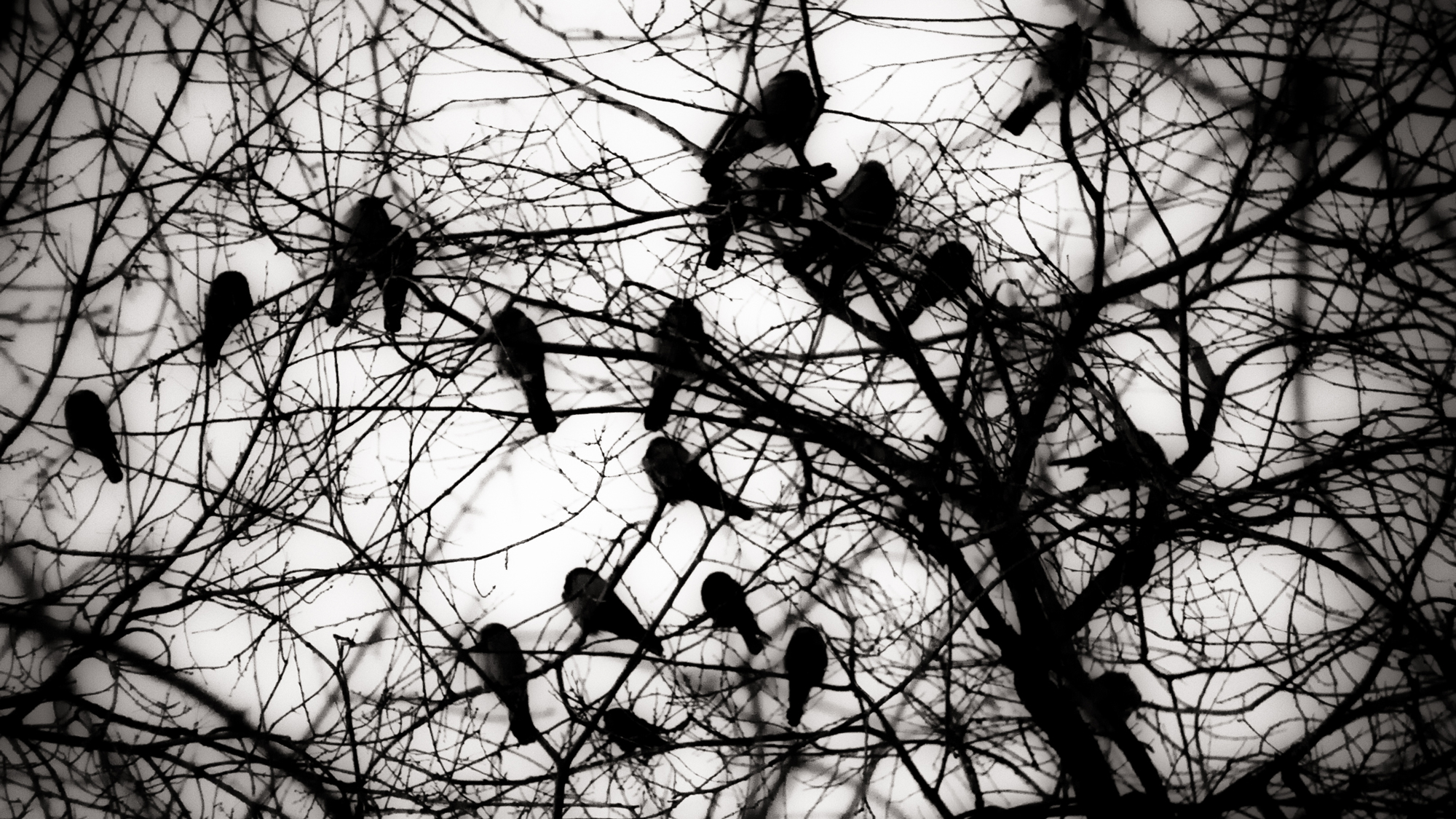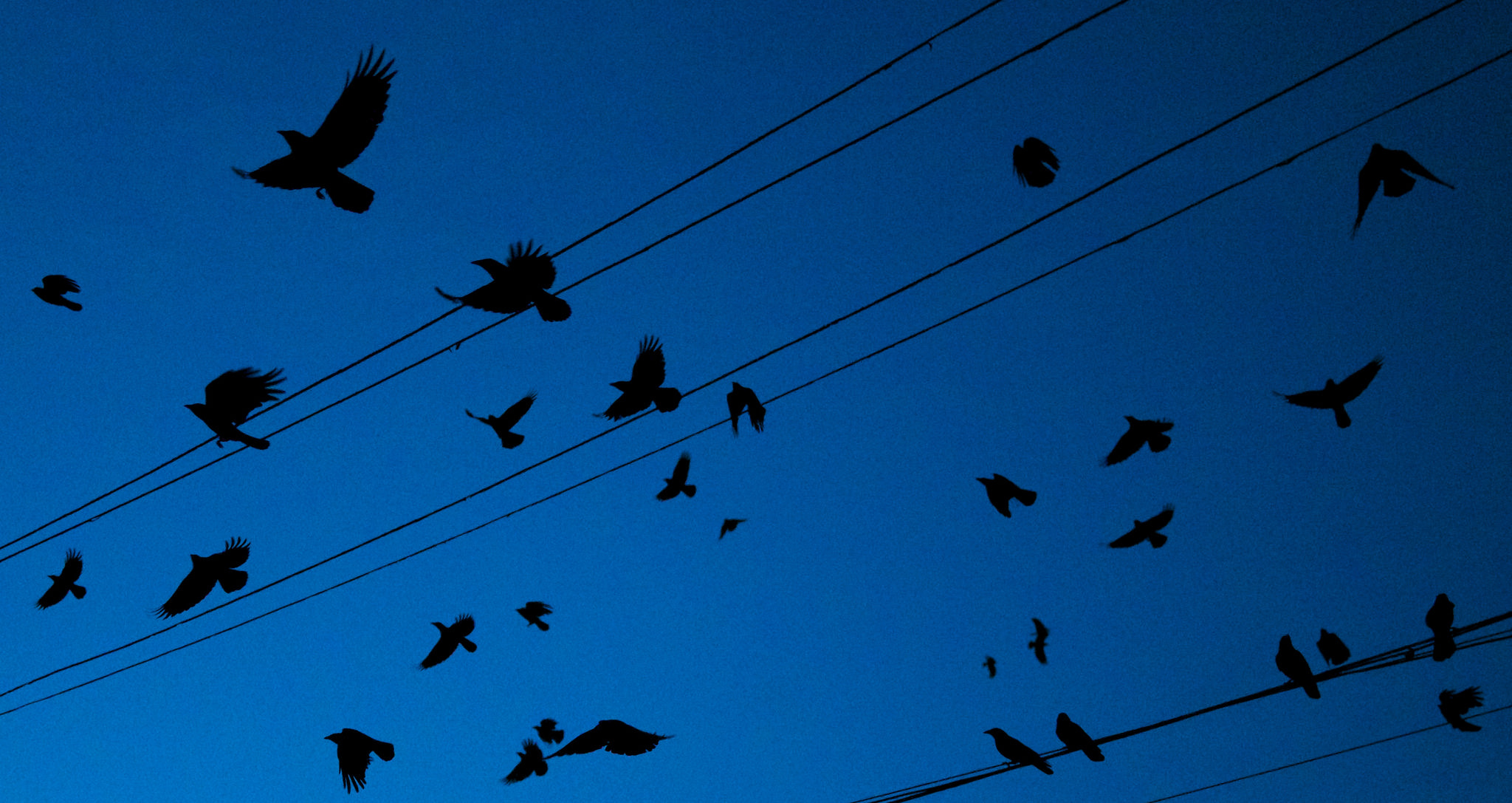Hundreds of crows are standing stock still in orderly rows on the University of Washington tennis courts. If their creepy gaze isn’t enough, nearby, overflowing a few leafless trees, is a cackling crow army, 10,000 strong. It looks as though the birds are going to take over the city of Seattle.
Seattle’s famously gray skies lend an air of Alfred Hitchcock to the scene, but this type of roosting behavior is common for crows. John Marzluff, a professor of forest sciences at the University of Washington who has been studying crows for over 20 years, described the scene in an NPR interview with Ashley Ahearn. Each winter 150,000 crows roost on the University of Washington, Bothell campus, actually causing the trees to slouch under their weight.
Birders and conservationists recognize crows as highly intelligent and complex animals. They mate for life, can live 20 years and have fascinating social lives. But when a huge group of crows — commonly called a “murder” — gathers in a city, human tolerance can be put to the test. Residents have described the crows as “creepy” and a “deafening black cloud” that completely blocks out the sun.
Knowing that there is safety in numbers, crows form massive roosts where they return to rest each evening, and during the day they disperse in groups to several staging areas within a short distance of their main headquarters. The locations of their roosts tend to change from year to year to decrease chances of becoming an owl’s lunch, and in winter when joined by migrating birds from Canada can grow to remarkable sizes.
While one documented roost in Oklahoma contained more than two million birds, most are much smaller. But thousands of crows are still highly noticeable.

These roosts and staging areas can be so noisy and immense that there have been instances of people going nearly insane from living near them. The incessant noise combined with the cultural association of crows being linked with evil or death can make the gatherings of crows a problem for some cities.
One such instance was in my town of Caldwell, Idaho, where I am a student in environmental studies at the College of Idaho. Each winter a murder of thousands of crows would gather in the local Walmart parking lot and create a ruckus filled with cawing and pooping. While a few people I know enjoyed watching the crows, they created an unfavorable reaction among locals.
Caldwell has a varied agricultural landscape, and worried farmers were calling the mayor and the police department for fear of the crows damaging crops. Local businesses were left with heaps of feathers and droppings to clean up each day from the birds and were worried this could effect business. After a few years of complaints, the Caldwell police department got desperate and took to shooting the birds out of trees in the night. Along with being an ineffective method to disperse crows, when residents found dead birds laying around the next morning, further upset ensued.
In a final attempt to cure the city of the crow problem, a bird control company was hired and through the work of shock sticks, reflectors and hazers the birds have left Caldwell … for the neighboring city of Nampa, just a few miles east.
Vickie Holbrook, the communications director for the city of Nampa, says that the city has received only two complaints about the birds in the past couple of years. “At this time, we don’t have any plans to address the crows,” she says. But while some cities may find the birds a nuisance, others actually enjoy their presence.
The residents of Bothell, Washington have a Facebook fan page titled “Bothell Crows” in which they post pictures of the birds, discuss interactions with them and share stories.
Susan and Ron Runyan, who live near the roost in Bothell, commented on the intelligence of crows and their grief at losing a comrade. “I was walking home and discovered a dead crow in the middle of the street, most likely hit by a vehicle. I couldn’t bear to see it destroyed even further, so I came back with a shovel and gently moved it off to the grassy shoulder. His ‘friends and family’ were quite vocal and hung close by. All I could do was say ‘sorry about your friend.’ Crazy, but I think they understood … and they became quiet.”

Bothell’s Animal Control Officer Debra Murdock says she has been personally dive bombed by these crows when she has been near a roost and there has been an injured chick or a member has died. In certain instances, she has had to wear a helmet to shield herself from their protective aggression, but there have been no instances of harm done to people or their pets.
At first glance, crow gatherings might look like complete chaos. But Marzluff speculates there is a pecking order of sorts among roosts. Birds roosting at lower spots in a tree will become covered with their friend’s feces throughout the night, while birds at the top may be more vulnerable to predators. The “zombie crows” lined up on the tennis courts at the University of Washington campus were most likely just scouting out the roost, waiting their turn to get a good spot.
Next time you see an enormous murder of crows flying overhead, rest assured it most likely isn’t signifying the apocalypse, but may just be the birds flying home to roost for the evening.



Tonight while walking there were hundreds of crows roosting in some trees a little way from where I was. I looked over my shoulder and saw a steady stream of crows joining the already roosting ones. As I got closer to them they began flying and eventually all the crows left these roosts and re-roosted in the trees in the area from which I just came. I find their habits fascinating and enjoy watching them….and want to learn more about them. This article was very helpful though.
They’ve driven out all the other birds, which in my opinion are friendlier neighbors and are more attractive. I’d like to see their numbers reduced.
I Love Watching Crows ?. They show up in huge numbers in Bluefield West Virginia.
Today, I decided to quit smoking. Then I heard the crows. Any connection? I have lived here 26 years and have never seen more then 10 at a time. There were at least 50 of them today in a tall tree next door. I am going to assume they were wishing me well.
seems like it, so let it be your sign! it shows strength and intelligence to put the cigs down, so let the crow’s strength and intelligence be your call to stay as such!
I have always Loved the crows!
They are so intelligent amazing birds.
Live in the same area my whole life ( in a city in ne pa.) and there has always been crows living in one particular tree as far back as I can remember. Lately I have seen many more crows and they are in flight. It seems they head the same way each evening. Is it a certain time of year that they do this because it doesn’t happen year round? It’s something different to me and again I’ve been here for over 60 years.
While I don,t have the great numbers of crows your speaking of , I just have maybe ten or so , but , the analagy of a pyschotic neighbours is apt as annoying goes. Dave Black Creek , B.C.
Counted over 300 flying S by SW yesterday morning over Shields, MI .
Excellent -thanks for explaining our murder of crows that gather every year in my neighbourhood in Calgary, Alberta.
Every year, around this time, we have the pleasure of watching their highly complex social structure.
I hear them each morning at dawn as they head west to feed on the wheat fields and return every night at dusk to roost in the forested park ridge near our homes.
We estimate about 400-500 gather here. My guess that they are migrating now seems to be accurate as they head to Washington state- I think!
Yesterday, we had the privilege of watching hundreds sore on the icy north wing that blew in and they’ve were surfing the currents…. what a complete natural phenomenon I felt honoured to watch!
Thanks Mother Nature and your charming creature – we have so hey much to you. ??
I have never seen a real life murder of the crows but I’ve seen a flock of about 20. They have become a kind of menace to maize farmers around my home(Kamara,Kenya) every time they come around but I still enjoy their presence. To me, it means the place is environmentally safe for them to stick around.
When I lived in Portland Oregon a few decades ago, crows roosted in a 100 foot Douglas fir in our yard near the house (the tallest tree for several blocks). For about 45 minutes each evening, the din was so loud one could not carry on a conversation or hear the tv. Then it would grow quiet, and stayed that way through the night. My neighbors grew used to it, and I think were awed at the spectacle as the birds would alight in a cloud over my house and resettle in the tree several times during the evening. In morning the birds were gone: they simply woke at dawn and dispersed for the day. This went on for several years. The plants under and around the tree, by the way, thrived.
It changed abruptly one year when a pair of ravens decided to roost near the top of the tree. The crows came that first year, but quickly found another overnight roost a few blocks away. It was clear that what ravens want, ravens get! For the next several years, until we moved, we were treated to an entertaining variety of sounds that the young ravens learned. We often heard such things as a chicken announcing the appearance of an egg, the bark of a small dog (ours), the sound of the wind when it rounds the corner of the house– all from high overhead. The one we enjoyed the most, though, was the sound of our squeaky screen door opening and then closing with a slam– from the top of the tree!
I have always loved crows .They are fascinating creatures and deserve respect. I raised one once and it
acted like a dog w/ me. It was one of the best experiences of my life. I too have seen murder of crows in my
town and it is entertaining to watch how they act w/ one another… Love the article. Thanks !
Crows are known to be highly intelligent and would imitate human behavior. I forgot where I read this from, but during winter, kids in a neighborhood would go sledding. Just by watching kids sled from the top of a hill, these couple crows quickly learned to find materials that they can use as sleds and started sliding down the snow covered rooftops. There were also reports on how crows imitate human’s behavior at funerals, when one of the crows pass away, others will go up to its body one by one to pay respect and say bye.
What a great article! Crows and ravens are among my favorite birds because of their intelligence and playfulness. Thank you for writing about all the reasons we should appreciate them!
Bethlehem PA-Christmas City, hosts a murder of crows in the tens of thousands if not more. It is a spectacular thing to see! Though there are many folks that would love to see them leave.